Last Updated on February 2, 2024 by Matt Greene
The shaft in your golf clubs connects your swing to the golf ball so playing the correct flex shaft is very important.
Playing the wrong golf shaft flex can lead to bad habits in your swing that become difficult to fix in future.
But playing the right flex for your swing promises you massive distance, straighter shots and longer carry.
This is a full guide on golf shaft flex including charts and expertise of club fitters, so you'll know everything there is to know about shafts by the end.
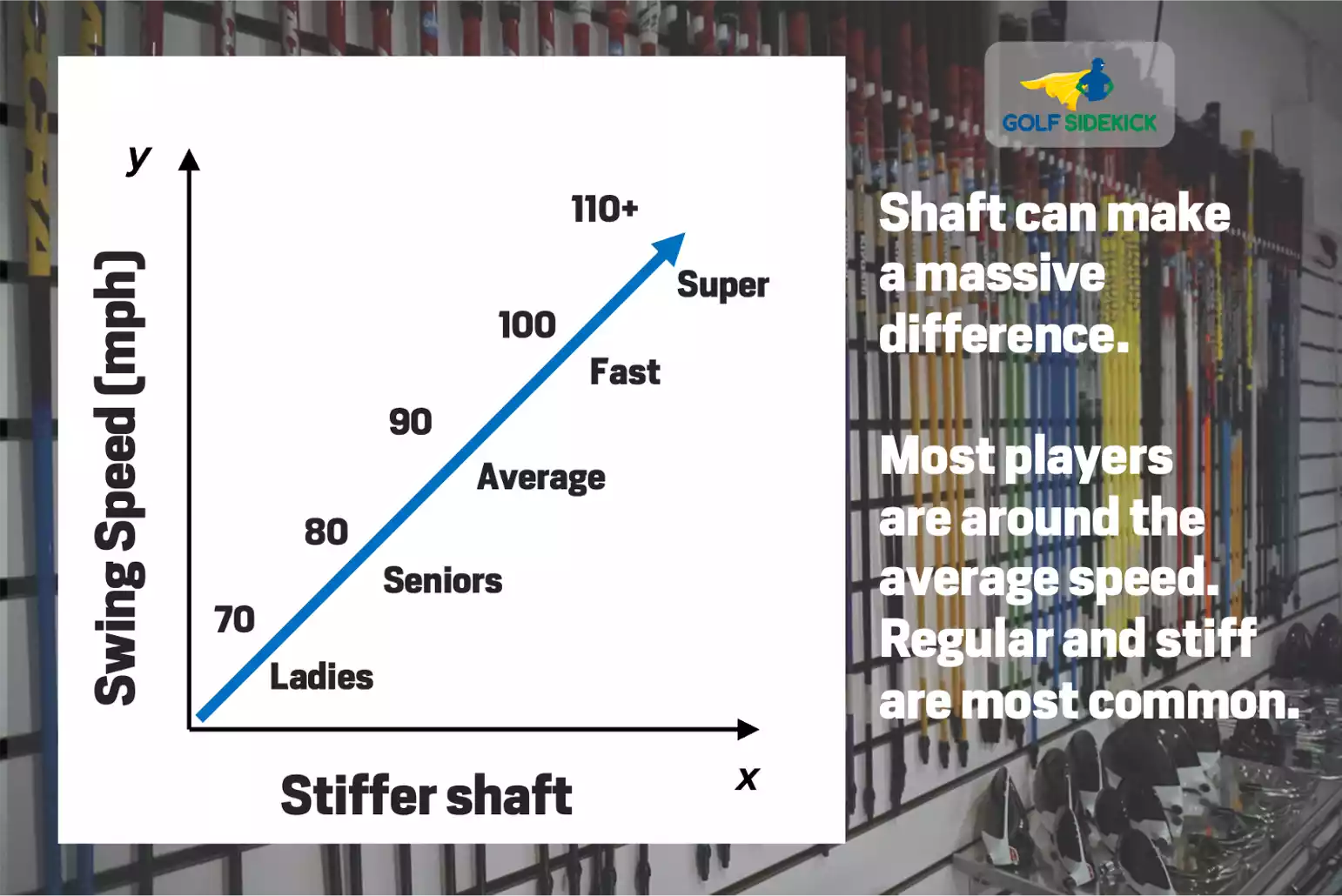
What Is Golf Shaft Flex?
Flex in a golf shaft determines the amount the shaft bends during the swing and at impact. Depending on the manufacturer, shafts fall into categories such as extra stiff, stiff, regular, ladies, or senior flex.
Pros or low handicap golfers, tend to use stiffer shafts to adjust to the faster swing speeds and torque generated by stronger golfers to give the club head the best chance of being in the exact position it needs to be at the point of contact.
Players with much slower swing speeds, such as juniors, seniors or lady golfers, use a softer flex shaft like Ladies or Senior flex to allow the club head to hit the ball with a square face.
What is torque in a golf shaft?
Torque is a measurement of how much a shaft resists twisting during the golf swing. It is measured in degrees, which denotes how many degrees the shaft will twist under a given force.
Torque is important. Feel is just as important in a golf swing. It's a complicated topic best solved by an expert fitter like Eric Chong from Impact Golf Malaysia.
Golf Shaft Flex Letters
Have you ever seen the letters on a golf shaft and not understood what they mean? Here's a clear breakdown of what golf shaft letters mean:
- SR = Soft Regular in America/Europe
- R = Regular flex
- SR = Stiff Regular in Asia
- S = Stiff
- S+ = Stiff Plus
- X = Extra stiff
- TX = Tour Extra stiff
Specialty shafts:
- L = Ladies flex
- A = Senior flex
- W = Wedge flex
Golf Club Shaft Flex Chart
This is a really useful golf shaft stiffness chart that matches up swing speeds to the appropriate flex. This is a good guide but as always, if in doubt, see a professional club fitter for advice because your tempo and transition determines the kick point in your shaft as well as the weight and flex.
| Swing Speed | Club | Clubhead Speed Range | Shaft Flex |
| Very Fast | Driver | 105 mph + | X Stiff |
| 3 Wood | 100 mph + | X Stiff | |
| 3 Iron | 97 mph + | X Stiff | |
| 6 Iron | 92 mph + | X Stiff | |
| Fast | Driver | 97-104 mph | Stiff |
| 3 Wood | 93-97 mph | Stiff | |
| 3 Hybrid | 90-96 mph | Stiff | |
| 6 Iron | 84-91 mph | Stiff | |
| Average | Driver | 84-96 mph | Regular |
| 3 Wood | 84-93 mph | Regular | |
| 4 Hybrid | 80-90 mph | Regular | |
| 6 Iron | 75-83 mph | Regular | |
| Slow | Driver | 72-83 mph | Senior |
| 3 Wood | 70-80 mph | Senior | |
| 4 Hybrid | 68-78 mph | Senior | |
| 6 Iron | 65-75 mph | Senior | |
| Ladies | Driver | < 72 mph | Ladies |
| 3 Wood | < 70 mph | Ladies | |
| 4 Hybrid | < 68 mph | Ladies | |
| 6 Iron | < 65 mph | Ladies |
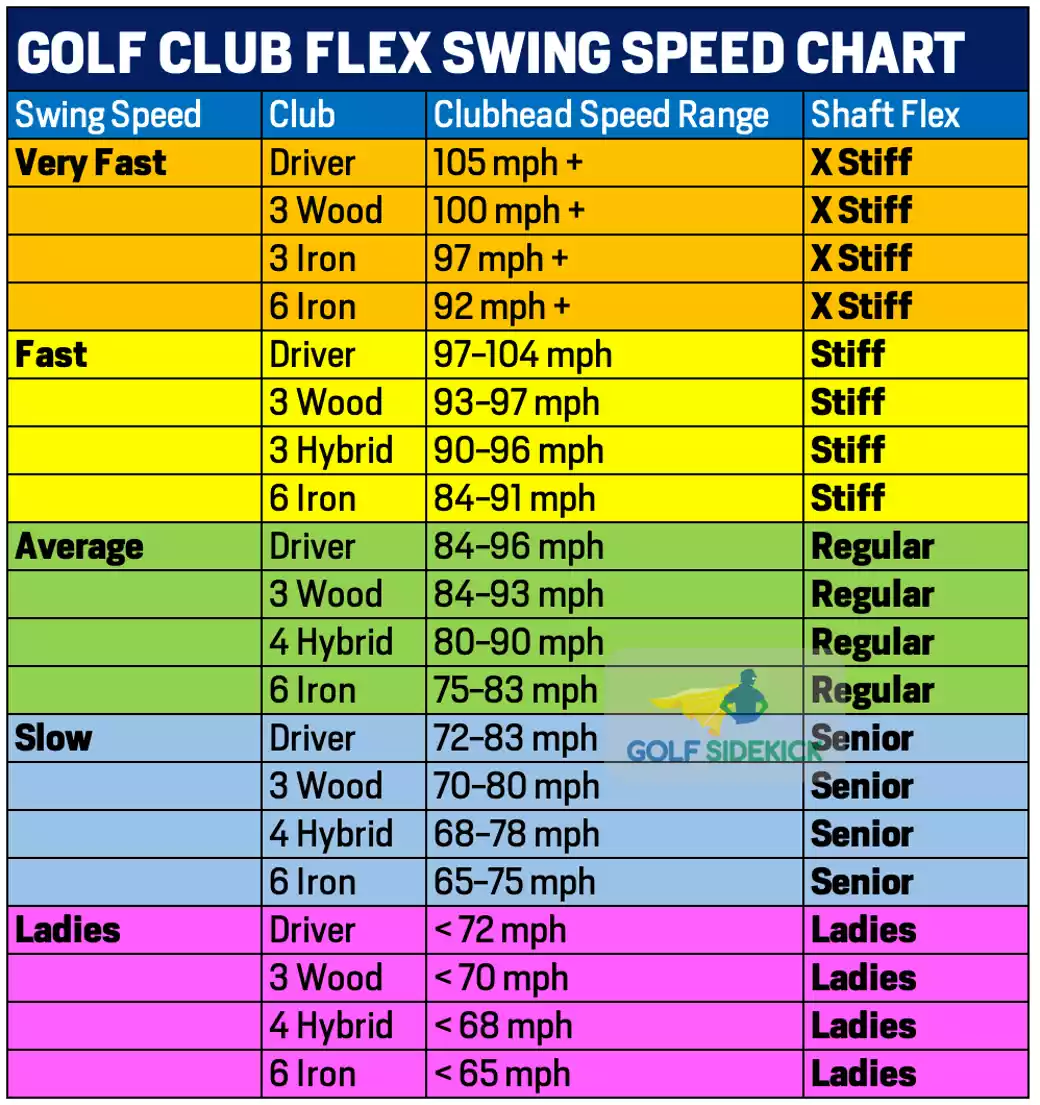
How the flex of the golf shaft impacts shot shape
The flexibility of the golf shaft affects your shots in the following ways:
- The shaft flex influences the launch height and overall height of your shots.
- The shaft influences how much spin you put on the ball.
- The shaft flex influences the feel of the golf club whether it feels like an extension of your body or something totally foreign.
Golfers with high swing speed must use stiffer shafts because when a soft shaft bends under high swing speed it "lags" behind where it should be and the club head can't catch up with your hands. At the bottom of the swing, near impact, the club face could be pointing left or right and that causes inconsistent shot shapes.
On the other end of the scale, if you're a golfer with a slower swing speed using a stiff shaft, you may struggle to close the club face at impact, resulting in a dreaded slice. Compressing the golf ball is key to more distance and with the correct shaft, a better strike of the golf ball will increase your distance, lower your spin and improve direction.
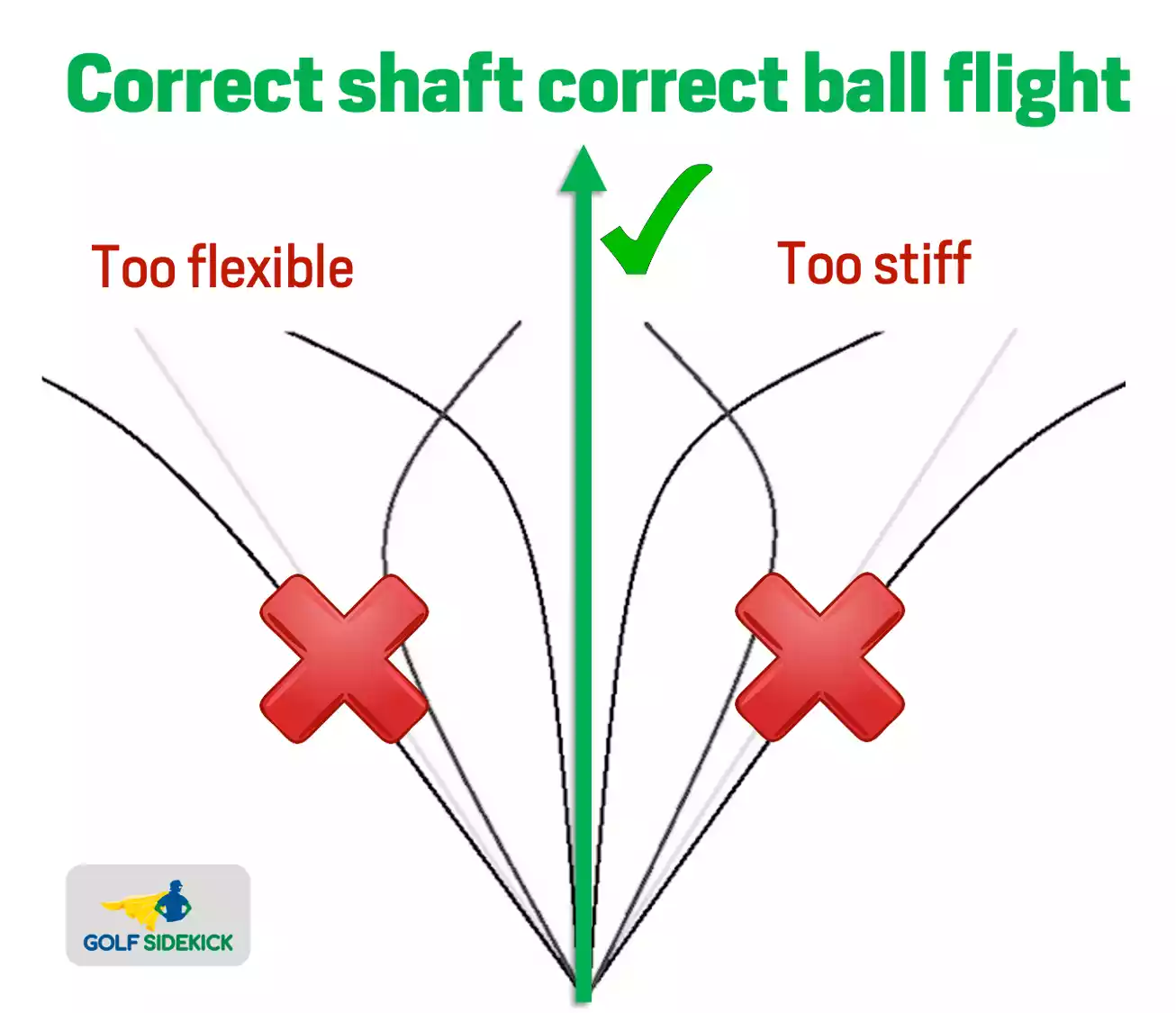
What we want is to manage the spin rate of the ball which is generated relative to the swing speed of the golf swing. More speed can result in more spin, and more spin can result in a loss of distance as the ball balloons in the air. However, spin is needed to get the ball airborne, so slower swing speed golfers need a shaft which generates enough spin to help them out in this area.
As a general rule, you should use the same flex shafts in all of your clubs, with the exception of your wedges. Wedges tend to have stiffer shafts, known as "wedge flex". They're not overly stiff, but they do encourage accuracy in these precision clubs.
You can judge the right flex shaft for you based on feel, and some people swear that in the hands of an amateur, flex doesn't matter. I think that shaft flex is an essential timing element in the golf swing, and to get this part of the game right, I always recommend seeking the help of a professional club fitter.
Shaft Flex by Golf Swing Speeds
Working out the correct shaft flex for you is usually done by working out your swing speed and then seeing which shaft flex is right for the club head speed you're generating. All of these speeds are with a driver.
- Under 75 mph – Ladies flex or Senior flex
- 75 to 95 mph – Regular flex
- 95 to 110 mph – Stiff flex
- 110 mph and up – Stiff or Extra Stiff
This is a basic guide to follow.
What Do Golf Shaft Flex Numbers Mean
Golf shaft brands like Project X use numbers on their golf shafts instead of letters to denote the flex of the shaft. For Project X shafts, the higher the number on the shaft, the stiffer the shaft.
Project X Golf Shaft Flex Chart
- 7.0 - Tour extra stiff
- 6.5 - Extra stiff
- 6.0 - Stiff flex
- 5.5 - Regular flex
- 5.0 - Senior flex
Signs you need a stiffer shaft
As you get better at the game of golf, our develop a more confident swing, you may begin to think that you need a stiffer shaft in your clubs. There are a few signs that this might be the case which are;
- You're hooking the ball with your clubs
- You can't control the distance of your irons consistently
- The golf ball balloons in the air with driver, hybrids and fairway woods
- You can't feel the club head in your swing
When to switch from stiff to regular shaft
I often find that too many players use stiff flex shafts. There is nothing wrong using a regular flex shaft and in truth shaft flex has no relation to skill level in golf. I have played with and had my ass kicked by plenty of seniors who are using super light and whippy shafts.
Here are some signs that it's time to switch from a stiff to a regular shaft;
- You are hitting slices with your driver
- You can't get the ball of the ground with woods and long irons
- Ball flight is weak with mid and short irons
- No spin on approach shots
These are some of the tell tale signs of a shaft which is too stiff for you.
What Shaft Flex Should I Use For My Driver
If you’re between 97 and 104 mph with the driver, you need a stiff flex.
If you’re between 84 and 96 mph, regular is going to be best for you. This is the swing speed rage of most amateur golfers.
Between 72 and 83 mph with the driver signifies you need to be hitting senior flex.
Swing speed for stiff shaft irons

| 6-iron Carry Distance | 6-iron Swing Speed | Driver Swing Speed | Shaft flex (all clubs) |
| < 130 yards | 60 – 70 mph | 75 – 85 mph | Senior Flex |
| 131 – 155 yards | 71 – 80 mph | 86 – 95 mph | Regular Flex |
| 156 – 175 yards | 81 – 90 mph | 96 – 105 mph | Stiff Flex |
| > 176 yards | 91 + mph | 105 + mph | X-Stiff Flex |
7-iron swing speed chart shaft flex
| 7 iron distance | Full Swing | 3/4 Swing | Half Swing |
| <115 | LADY FLEX | LADY FLEX | SENIOR FLEX |
| 115-130 | LEDY FLEX | SENIOR FLEX | SENIOR FLEX |
| 130-145 | SENIOR FLEX | REGULAR FLEX | REGULAR FLEX |
| 145-155 | REG FLEX | REGULAR FLEX | STIFF FLEX |
| 155-165 | STIFF FLEX | STIFF FLEX | STIFF FLEX |
| 165-175 | STIFF FLEX | X STIFF FLEX | X STIFF FLEX |
| 175+ | X STIFF FLEX | X STIFF FLEX | X STIFF FLEX |
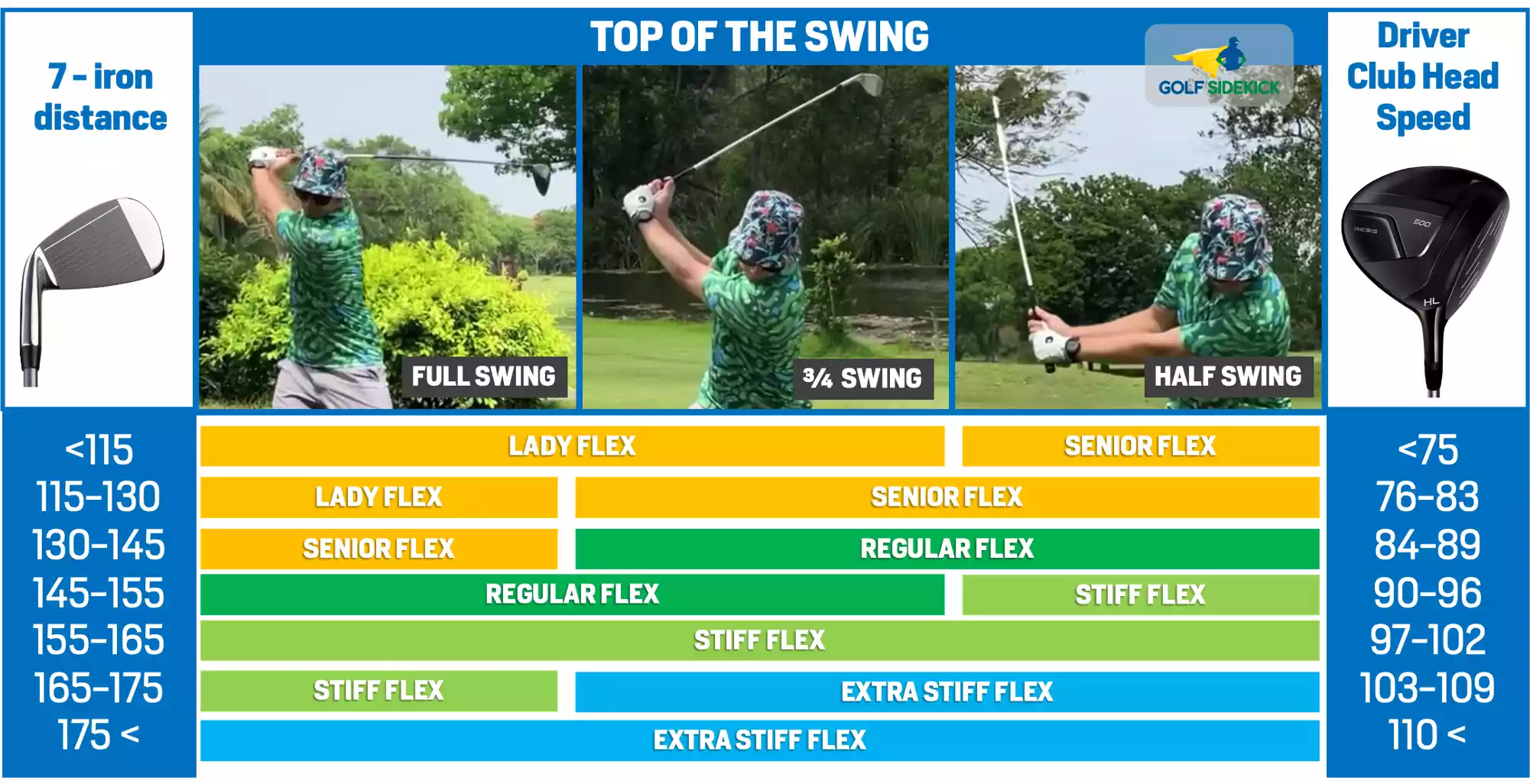
KBS shaft chart

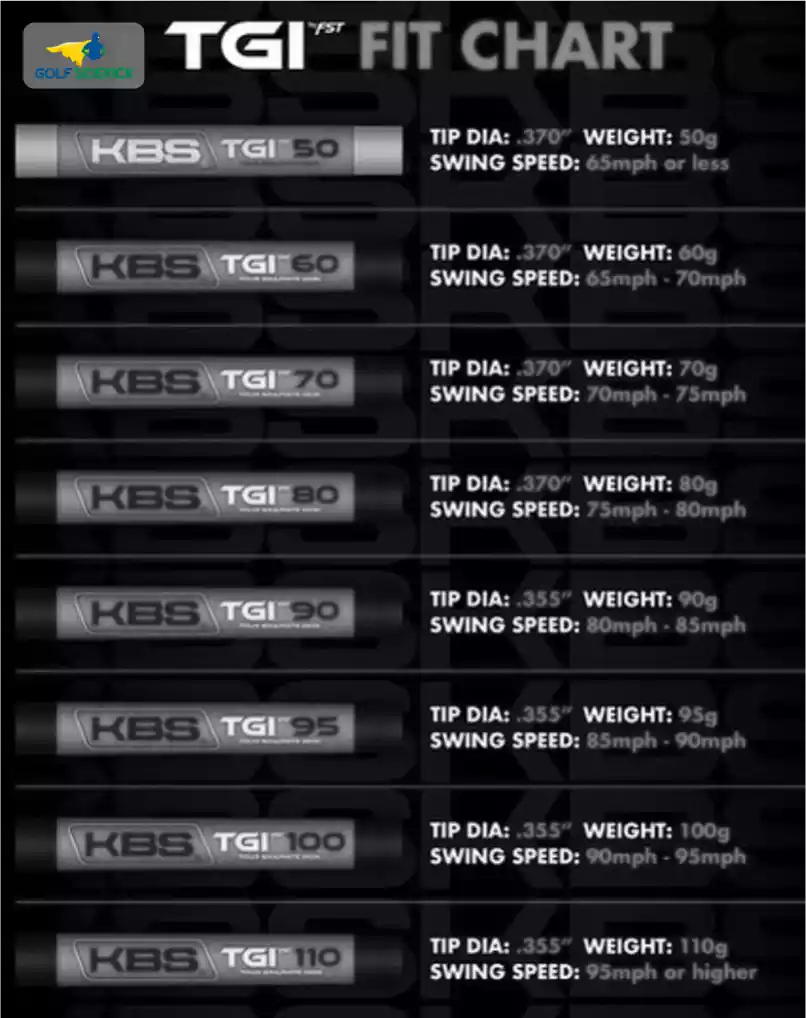
Project X Shaft Flex Chart
Original Project X Rifle Irons
Tapered
- Regular – 5.0
- Regular Plus – 5.5
- Stiff – 6.0
- Extra Stiff – 6.5
- Extra Stiff Plus – 7.0
Parallel
- Regular Plus – 5.5
- Stiff – 6.0
- Extra Stiff – 6.5
Original Project X Woods & Hybrids
- Regular Plus – 5.0
- Stiff – 5.5
- Stiff Plus – 6.0
- Extra Stiff – 6.5
- Extra Stiff Plus –7.0
Project X 95 Flighted Irons
- Regular – 5.0
- Regular Plus – 5.5
- Stiff – 6.0
- Extra Stiff – 6.5
- Extra Stiff Plus – 7.0
PXi Irons
- Regular – 5.0
- Regular Plus – 5.5
- Stiff Plus – 6.0
- Extra Stiff – 6.5
Rifle Irons
Parallel
- Senior – 4.0
- Regular – 5.0
- Stiff – 6.0
- Extra Stiff – 7.0
Tapered
- Senior Plus – 4.5
- Regular Plus – 5.5
- Extra Stiff – 6.5
PX LZ Steel Irons
- Regular – 5.0
- Regular Plus – 5.5
- Stiff – 6.0
- Stiff Plus – 6.5
PX LZ Tour Graphite Irons
- Regular – 5.0
- Stiff – 6.0
PXv Tour Graphite Woods
- Stiff – 5.5
- Stiff Plus – 6.0
- Extra Stiff Flex – 6.5
- Extra Stiff Plus – 7.0
Project X Black Woods & Hybrids
- Stiff – 5.5
- Stiff Plus – 6.0
- Extra Stiff – 6.5
- Extra Stiff Plus – 7.0
HZRDUS Woods & Hybrids
- Regular Plus – 5.5
- Stiff – 6.0
- Extra Stiff – 6.5
HZRDUS T1100 Woods
- Regular Plus – 5.5
- Stiff – 6.0
- Extra Stiff – 6.5
EvenFlow Woods & Hybrids
(Available in Black and Blue)
- Regular Plus – 5.5
- Stiff – 6.0
- Extra Stiff – 6.5
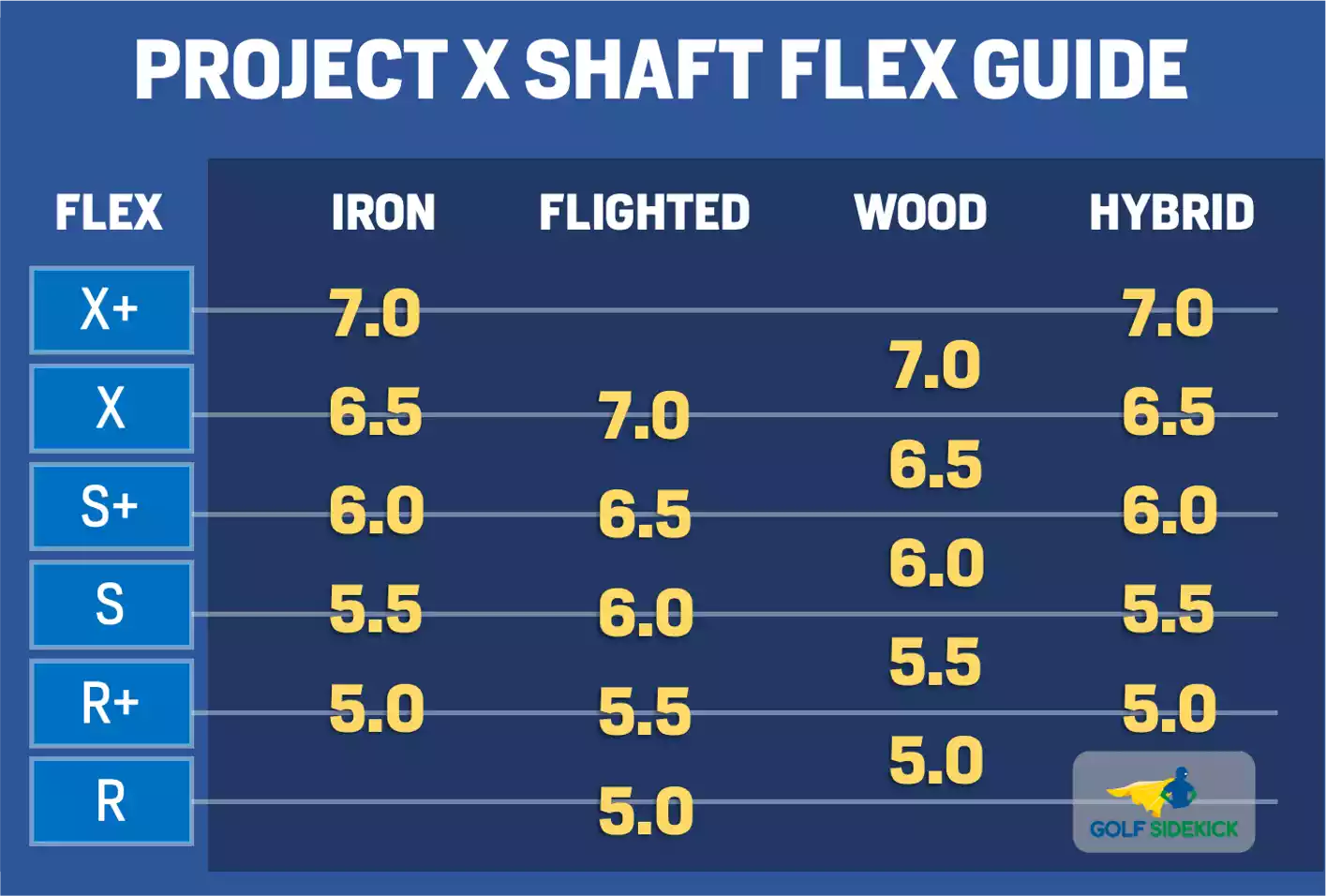
Conclusion
Using the correct shaft flex for your game is essential. You don't want to add shots because of your equipment and a poorly fitted shaft could be the cause of those wild hooks and slices. See a pro club fitter and get the right shaft for you.
